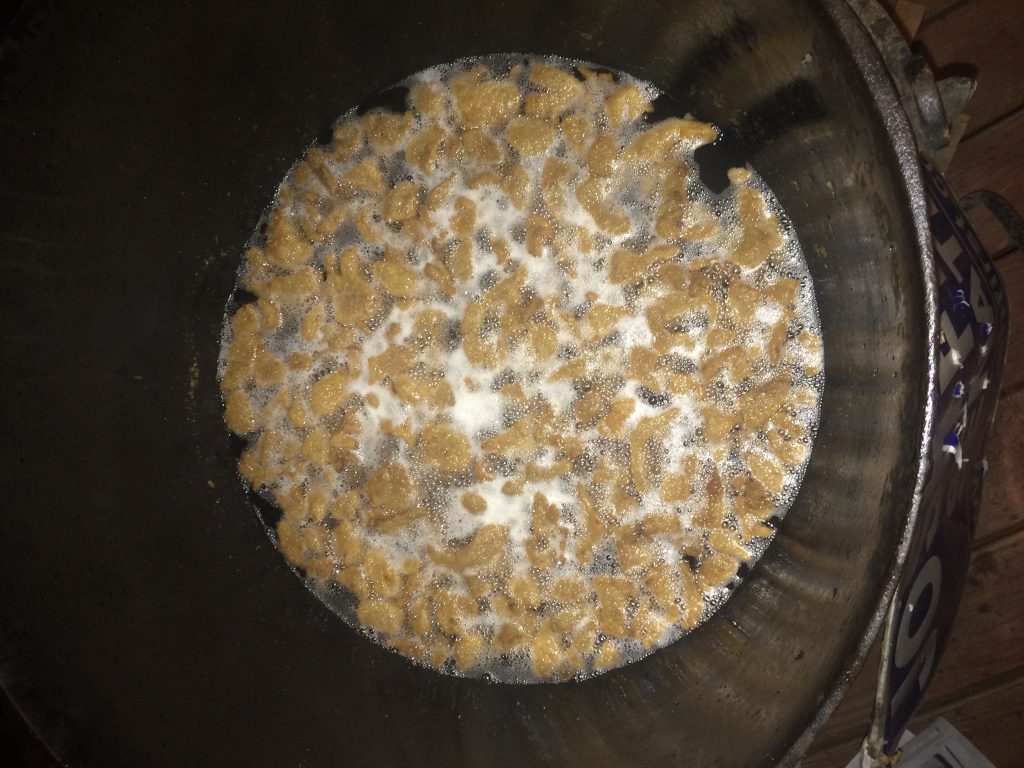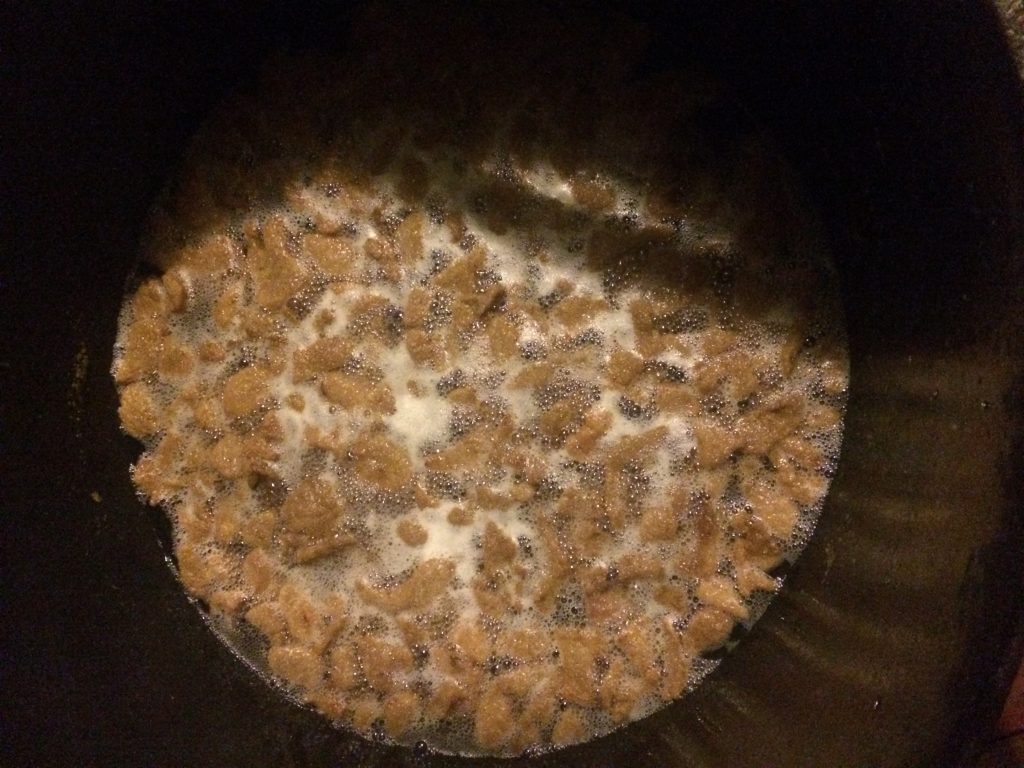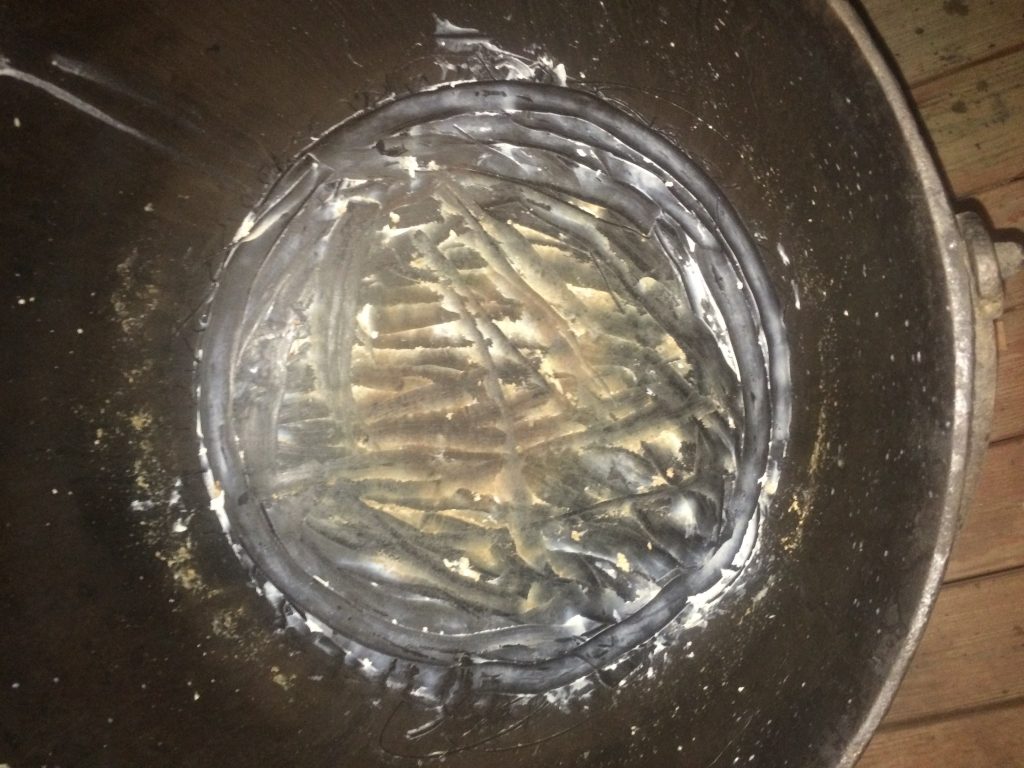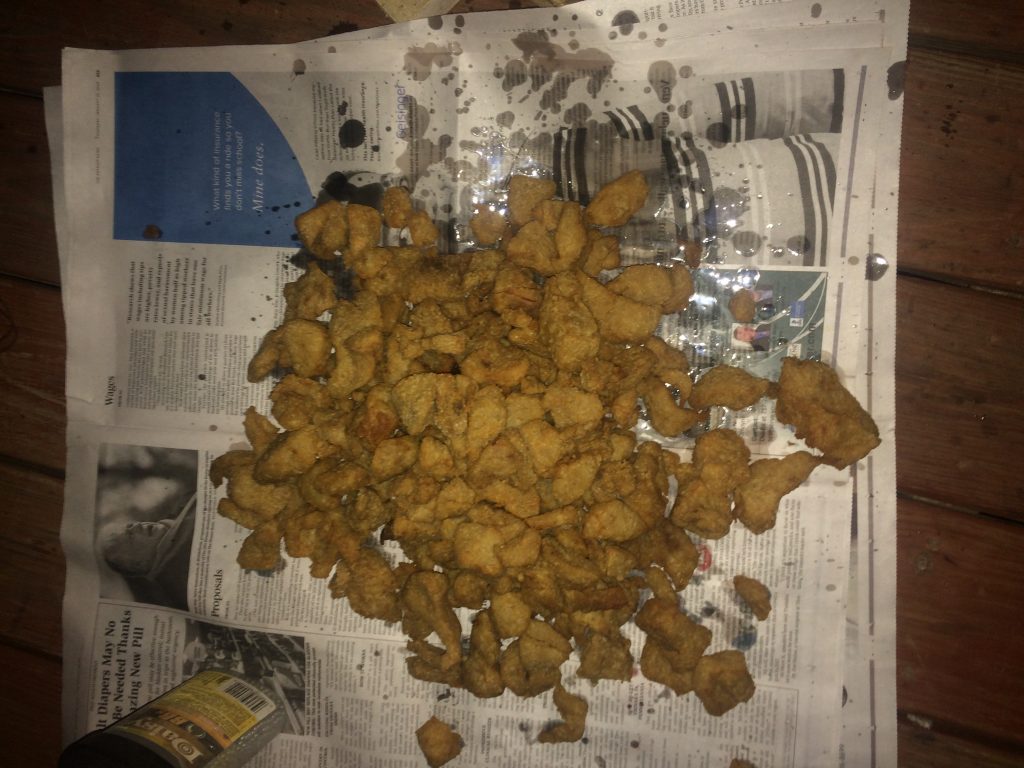Rendering bear grease, Round II
Last year was a first try at something that has beckoned for a long time, and that was making bear grease out of bear fat. If you search here in the blog you will see the kind of double boiler approach that effort started with, and you will see that it took too long, though it did provide a good product.
Why would someone want to make bear grease from rendered bear fat? Fair question.
To begin with, in the natural world, fat is a major and valuable commodity. It is important to survival and is hard to come by; under normal natural conditions, it is a sign of high health. Only in modern, materially successful, over-consumptive Western countries has high human fat become a liability, a health problem. Just a couple hundred years ago, heck even a hundred years ago, most Americans could not eat enough to make up for the energy they spent during their daily lives. Today we Americans are overfed and sedentary, eating ourselves into early health problems. We do not move enough. So we look at fat and think fat is “bad.”
But bear fat is especially good. Because they hibernate from late November through March, bears usually pack on a tremendous amount of fat starting in July and August. The fat reserves they build up will feed their sleeping bodies over the long cold winter in a specialized and not totally understood way. Bear fat is very different from any other kind of fat you will ever see, and some people have said it most closely resembles whale blubber. While whales do not hibernate, they are warm-blooded mammals that occupy freezing cold oceans and dive to unbelievable depths for food. Such a hostile surrounding requires a wall of natural fat that both protects and feeds the whale’s body. So bear fat is supposedly a lot like whale fat, which means it is unique and performs unique tasks that most other animals do not require.
[Sidebar here: Think about the Canada Toad, which survives in frozen tundra by having its body freeze solid over the winter, while a special hormone keeps its blood thinned, liquid, unfrozen, and moving slowly throughout its body to keep its organs alive. Some of these adaptive traits are things we humans can benefit from for medical purposes, if we but care about the animals’ habitats so that they are around when we get around to wanting to study them]
Think about Inuit and Inupiak (“Eskimos”) in the Arctic Circle and North Pole region. Even today, many of them will sit down and eat raw seal and whale blubber as a snack, usually warm right off the carcass. Clearly this is not a bad thing, as these impressive and hardy humans have thrived on this natural food for at least 15,000 years in the most brutal conditions. So again, bear fat is closely related to these other sources of needed fat and thus it is a good fat. If you were to consume mostly bear fat in your daily diet, your body would probably function a lot better. I am willing to bet that bear fat is far easier for human stomachs to break down and for human bodies to metabolize than dairy butter, deadly chemical margarines, and beef and pork tallow.
So why would I make bear grease from bear fat? Because I want to, that’s why. I am drawn to natural living and natural things, and getting back to basics is what a healthy life is all about. While I myself will not eat bear fat or grease (or whale or seal blubber for that matter), there are many people who I care about who can and will eat it. Plus there are other uses for it, which I have experimented with and found it to be amazing. Those uses are as a leather preservative, and bear grease is AMAZING at this, far better than anything you can buy. And then there is the lubricating function on a patched round ball rammed down the barrel of one of our flintlock rifles. So far I have seen bear grease provide a longer lasting, better lubricating film on the metal than any other bullet lube I have used. And I use all the best commercially available bullet and patch lubes on the market. Finally, I have begun experimenting with bear grease as a rust preventative on steel, like shop tools and machine parts. I am in the middle stage of this experiment, so right now I have nothing to report back with. But if it is anything like the patch lube effect on our rifle barrels, it will be excellent.
And again, yes, if you want to bake pastries with bear grease, you can. People say it is absolutely delicious and the best of all oils for that use. Some of the recipients of the bear grease I have created will probably do that. If I hear from them, I will report back here.
So this time around, I used an antique cauldron. A big one, on a tripod, over a propane burner. The fat came from a 611-pound male black bear killed by Travis Dietrich here in Dauphin County, on ground I manage. Travis was able to get about 40 pounds of bear fat into a cooler, and it has sat in a freezer or outside in the frozen cold, since Travis dropped it off at my home a month ago. The cauldron could have held a lot more bear fat, probably a few hundred pounds of it, but we puny humans could only remove and store that one big hunk this time, and so that is what we had to work with. Last year I had about five pounds to work with, from a young, tender bear killed by Kenny Youtz, actually very close to where this year’s bear was taken.
Maybe the next time a bear is killed, we will just move the cauldron and burner to the bear and start tossing the fat right into the pot. That way we can get all of it used, at its freshest, and waste nothing.
Learning from last year’s experiment, the double boiler method was just too damned long. So this time four gallons of well water were poured into the cauldron and heated to a boil, and then chunks of trimmed and cleaned bear fat were tossed in. Remember last year: Include zero meat, and I mean none, not even a tiny sliver, if you want a smell-free grease to result. Even the tiniest pieces of meat impart a pleasant but very meaty aroma to your leather preservative.
Fat chunk sizes ranged from fist to finger, and one of the lessons learned in this trial is that size matters. Actually, smaller is better when it comes to rendering bear fat. Most of the people who do this regularly use a meat grinder to get the bear fat broken down into strands that really truly cook down, quickly, and give up as much of the fat content as can be had.
And let us take note: Bear fat itself is kind of…a meaty consistency. It is not like any fat you have handled before, unless you work on a Japanese or Russian whaling ship, or you are a whale or sea mammal biologist (studying cetaceans). So cutting up the fat with a knife takes time. Use a clean cutting board and be prepared to resharpen your knife along the way.
What was learned this time is that the initial boiling water does buffer the process. It starts gently melting the bear fat and creating a pool of rendered liquid that will itself become the direct rendering agent for the bulk of the fat chunks after the water has steamed off in a great billowing mass. And when the water has boiled off, which you can tell because the steam is reduced and is becoming replaced with light smoke, turn down the heat, or the grease will quickly scald and burn, and then you have just about ruined it. The pool of grease that has been rendered so far will then get to work on rendering the rest of the fat remaining in the pot. It is like deep frying fat chunks.
The resulting chittlins (or cracklings as some people call them) are supposed to be really tasty, and I saved mine for friends to eat and for my own trap bait. Yes, some people will eat trap bait. Or, some people will use gourmet cuisine as trap bait. Strange world we live in. Take your pick.
This has been a lengthy post and I am about out of time and words. Here were my takeaways this time:
- Render your bear fat as fast as you can. The longer it sits, the more you will get some faint rancidity on the surface that must be trimmed off.
- Cut your bear fat chunks as small as possible, using a meat grinder if possible.
- Do not over heat or overcook the bear fat. This year it was on the slightly over-cooked side, because I was operating in the dark and did not notice just how deeply brown the chittliins had become. A slight brown shows they are cooked. A deep brown shows they have been completely deep fried and the oil has become super heated. The oil/ grease will then become brown from the high heat. We are aiming for a creamy white grease that solidifies easily when refrigerated or frozen.
- You can strain your bear grease through a cloth or coffee filter, but I did not. As I am not eating it, I just left the cauldron outside overnight in the 25-degree cold, which caused the grease to congeal. In the early morning I scooped up the best fat first, which is easily identifiable as the hard white tallow. Below the surface was the slightly brownish grease with a slightly grainy texture, and then below that were the fine particles that were not scooped out with the strainer. I took everything, each with its own use and purpose. The bottom of the barrel, so to speak, was taken for my friends’ dogs, which will probably enjoy the tasty treat and get a super glossy coat of hair. The creamy white, hard tallow is best for leather preservative. The brownish, unfiltered grease will harden up and is best for greasing ball patches and preserving steel surfaces.
Pictures and captions below should help, and I do hope this helps. Last year’s bear grease post was right up there in the top two or three on all the search engines, so people are really reading up on this neat process.
NOTE: WordPress has recently been “improved,” and it is now much less user-friendly, very hard to use. Especially with posting photos. When I went to the WordPress online forum today, a lot of other users are complaining. I have already spent a lot of time on this essay and lost half of what I put in. The new editor is terrible, and simply deletes a great deal of text. I apologize for the poor photo formatting, but I am not yet used to whatever “improvements” were made to the software. Believe me, I am trying to edit these, but the straight forward commands that WordPress had before are now gone. Like so many things digital today, “improvements” are made that eliminate the simplicity and ease of use of prior generations. Maybe this is a job guarantee for coders. Please bear with our technical difficulties…






Chittlins. I saved these as trap bait and for friends who like wild game cuisine. The newspaper underneath is the Patriot News, and this is the highest and best use for that partisan propaganda Fake News publication.
No Comment
Be the first to respond!